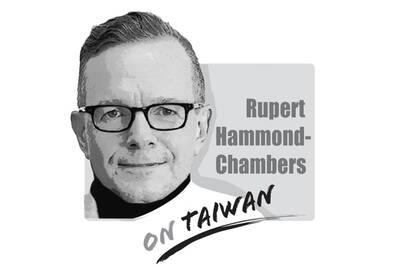On the eve of the sale of Next Media Group’s four Taiwanese outlets, a group of university students braved the chilly winds and the cold rain to stage a sit-in protest against “media monsters.” Their request to see Premier Sean Chen (陳冲) was denied. The day before, thousands of workers launched what they called an “autumn struggle” on Ketagalan Boulevard. The Presidential Office merely responded with a short comment.
A month ago, when workers knelt down in front of the Presidential Office to call for help in surviving, President Ma Ying-jeou (馬英九) went to see a movie. In the face of the nation’s various pension programs’ near-bankruptcy, the opposition camp has requested that Ma call a national affairs conference, but instead he held a closed-door meeting with the heads of the Cabinet, Legislative Yuan and Examination Yuan, rebuffing the opposition.
Judging from its reluctance to communicate with workers and the opposition, the Ma administration clearly does not take them too seriously. By comparison, its interaction with China seems to be much closer.
During the Chinese Communist Party’s (CCP) 18th Party Congress last month, Chinese President Hu Jintao (胡錦濤) once again emphasized Beijing’s opposition to Taiwanese independence. After the congress, on Nov. 20, former Chinese Nationalist Party (KMT) chairman Wu Poh-hsiung (吳伯雄) immediately met with China’s Taiwan Affairs Office Director Wang Yi (王毅) in China’s Fujian Province, pledging to further deepen exchanges across the Taiwan Strait, push for the establishment of offices on each side and amend the Act Governing Relations between the People of the Taiwan Area and the Mainland Area (台灣地區與大陸地區人民關係條例).
This is the dark side of the Ma administration. On the one hand, the KMT and the CCP have cooperated with each other to take control of Taiwan, but they do not care one iota about Taiwanese. The media monopoly, workers’ financial difficulties and national pension programs’ near-bankruptcy are all major issues, but so far, the government has refused to listen to the public or take any action. It even plays dead, showing that it is neither willing nor able to face and resolve these crises.
On the other hand, China is making every effort to annex Taiwan and its opposition to Taiwanese independence has always been consistent, so Hu’s emphasis on Beijing’s opposition to it is something of a non-issue. If the expression “Taiwanese independence” refers to maintaining the “status quo,” meaning the nation’s status as an independent and sovereign country, then that is a “Taiwanese consensus” acceptable to both the ruling and the opposition camps.
However, if it refers to a declaration of independence and the replacement of the Republic of China by a Republic of Taiwan, then that is a change that first has to stand up to the test of mainstream public opinion, as a part of the civic right of choice. Support for or opposition to such change is a question that should be resolved through democratic means.
China opposes Taiwanese independence because it wants to annex the nation. Still the Ma administration would rather join Beijing in its opposition to the public will. That not only jeopardizes Taiwanese democracy, it also causes domestic confusion and confuses the identification of friend from foe, and is likely to push the nation to the brink of disaster.
Ma, as president, represents all Taiwanese. He should have taken good care of their universal interests, but instead has repeatedly shut the door on them.
No wonder that criticizing the president has become a national pastime.
Lu Shih-hsiang is an adviser to the Taipei Times.
Translated by eddy chang
The gutting of Voice of America (VOA) and Radio Free Asia (RFA) by US President Donald Trump’s administration poses a serious threat to the global voice of freedom, particularly for those living under authoritarian regimes such as China. The US — hailed as the model of liberal democracy — has the moral responsibility to uphold the values it champions. In undermining these institutions, the US risks diminishing its “soft power,” a pivotal pillar of its global influence. VOA Tibetan and RFA Tibetan played an enormous role in promoting the strong image of the US in and outside Tibet. On VOA Tibetan,
Former minister of culture Lung Ying-tai (龍應台) has long wielded influence through the power of words. Her articles once served as a moral compass for a society in transition. However, as her April 1 guest article in the New York Times, “The Clock Is Ticking for Taiwan,” makes all too clear, even celebrated prose can mislead when romanticism clouds political judgement. Lung crafts a narrative that is less an analysis of Taiwan’s geopolitical reality than an exercise in wistful nostalgia. As political scientists and international relations academics, we believe it is crucial to correct the misconceptions embedded in her article,
Sung Chien-liang (宋建樑), the leader of the Chinese Nationalist Party’s (KMT) efforts to recall Democratic Progressive Party (DPP) Legislator Lee Kun-cheng (李坤城), caused a national outrage and drew diplomatic condemnation on Tuesday after he arrived at the New Taipei City District Prosecutors’ Office dressed in a Nazi uniform. Sung performed a Nazi salute and carried a copy of Adolf Hitler’s Mein Kampf as he arrived to be questioned over allegations of signature forgery in the recall petition. The KMT’s response to the incident has shown a striking lack of contrition and decency. Rather than apologizing and distancing itself from Sung’s actions,

US President Trump weighed into the state of America’s semiconductor manufacturing when he declared, “They [Taiwan] stole it from us. They took it from us, and I don’t blame them. I give them credit.” At a prior White House event President Trump hosted TSMC chairman C.C. Wei (魏哲家), head of the world’s largest and most advanced chip manufacturer, to announce a commitment to invest US$100 billion in America. The president then shifted his previously critical rhetoric on Taiwan and put off tariffs on its chips. Now we learn that the Trump Administration is conducting a “trade investigation” on semiconductors which